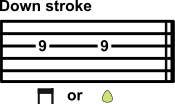Learn How to Read and Write Guitar Tab
This lesson will teach you how to read and write guitar Tabs.
See also: How to Read Music
What is Guitar Tab?
Guitar Tab is a clever invention that lets people easily communicate music written for guitar.
Tab is actually an abbreviation for the word tablature. Tablature is a shorthand for musical notation that indicates guitar fingering and other mechanics used to play a piece of music. Tab consists of a staff (lines and spaces) that mimic the strings of a guitar as well as various other symbols.

Benefits of Guitar Tab?
There are quite a few benefits to using guitar Tab.
- It's easy to learn.
- Tab is easier to read and write compared to standard music notation.
- If done right, Tab can show the timing and the technique used to play guitar music.
- It's a great learning tool.
- It's a fast way to communicate or archive musical ideas.
Guitar Tab symbols help communicate technique
Tab symbols help convey important messages to the reader about the techniques used to play particular notes.
While there are quite a few commonly used symbols, there is no set standard when it comes writing guitar Tab. You should always look for a legend provided by the Tab author for custom symbols he/she may have used.
Tab symbols and definitions
Here are some of the most used Tab symbols.
Hammer on - While holding the 7th fret with the first finger, slam down another finger on to fret 9 without picking.

Pull off - Opposite of a hammer on, a pull off lifts one finger to a held fretted note behind it causing it to ring.

Bend (full) - Note is picked then bent upward to a pitch a whole step higher.

Bend (1/2) - Note is picked then bent upward a 1/2 step higher in pitch.

Release Bend full and half - Starting from a pre-bent position a full or half pitch higher, the note is then picked and brought down to normal position.


Slide down - Pick the first note then slide your finger to the next note in the direction towards your head stock.

Slide up - Pick the first note then slide your finger to the next note in the direction towards the guitar body.

Legato slide - Slide from one note to the other without picking.

Ghost note - An audible note that is not picked and whose sound may be caused by the vibration of other notes.

Vibrato - Rapid bend and release of a string that causes the pitch of the note to fluctuate.

Wide Vibrato - Rapid bend and release of a string that causes the pitch of the note to fluctuate but with wider bends than normal vibrato.

Pinched harmonic - A pinched harmonic is caused by the pick or picking hand coming into contact with a ringing string. This usually generates a high pitched squealing harmonic.

Natural harmonic - A natural harmonic is the bell like sounds you get when lightly touching the strings above the fret then playing the string.

Palm mute - The string is muted using the meat of the picking hand near the bridge, pickups or sound hole.

Let ring - Keep the note ringing until the end of the dashed line.

Dead note - A note that is muted using the fretting hand.

Down stroke - Pick the indicated note or chord downward towards the floor.

Up stroke - Pick the indicated note or chord upward towards the sky.

Tapping - Indicates a note or series of notes where a finger of the picking hand "taps" on the fretboard to produce the sound at the desired fret number.

Fingering - Shows the finger number of the fretting hand used to play the note.

Pick scrape - The guitar pick is dragged down the length of the string.

Trill - Rapid hammer on and pull offs between two notes.

Tremolo bar dip - Tremolo / whammy bar is quickly depressed then returned back to note pitch.

Tremolo bar dive - Tremolo / whammy bar is depressed completely.

Note Duration - Note duration is not always displayed in Tab but when it is then it is usually placed under the staff.

Time Signature - Along with note duration, Tab can also show a time signature. In this case the time signature indicates 4 beats per bar with quarter notes getting the beat.

Guitar Chord Tabs
Chords are written in Tab with the fret numbers stacked on top of each other. Stacked numbers mean the fretted notes are played simultaneously. It's also helpful to write the chord symbol above it but you don't have to.

Write your Tab
How many times have you came up with a cool guitar riff or lick only to find that you have forgotten it the next day? My advice to you is write down everything that you want to remember. Soon you will have a library of licks.